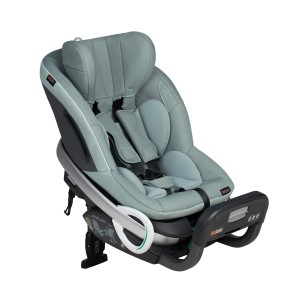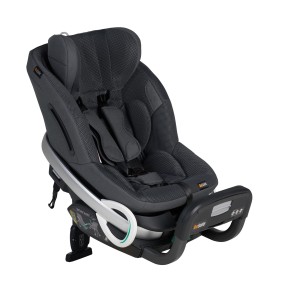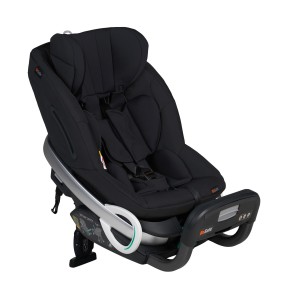Stretch Starting from € 749,00

The BeSafe Stretch car seat was developed to transport children rearfacing for longer. Because rearfacing car seats are up to 5 times safer.
This car seat offers plenty of legroom, up to 26cm, so that children from 6 months (61cm) to +/- 7 years (1,25m) can be transported rear faced. Moreover, there is no risk of outgrowing the seat due to weight first, as it has a carrying capacity of up to 36kg.
This BeSafe Stretch rearfacing car seat has a unique safety concept, the Exo frame construction. The Exo frame connects to the seatbelt and the floor to absorb forces in a frontal collision. The sturdy seat shell transports the child's energy to the Exo frame, keeping the child safely in the same seating position throughout the impact.
This car seat is suitable for any car and any seat, as it is installed using the car belt. The BeSafe Stretch can therefore be installed on car seats without ISOfix anchorage points. The BeSafe design team developed a low-threshold, easy and quick system to install the Stretch car seat easily.
Variations of this product
Reviews and experiences
Write a reviewFAQ
When installing this seat on the passenger seat, please check the following aspects:
1. As with all child seats on the passenger seat, you should still be able to see the side mirror of your car
2. You should have a minimum distance of 5 cm between the highest point of the seat or child's head and the front window
This seat already offers a very good recline. But if you have extremely steep vehicle seats and want to install the child seat a bit less upright, you can do this by having a small gap between front brace and sitting area of the vehicle seat - as long as these conditions are fulfilled:
1. the front of the base (near the support leg) has to rest on the vehicle seat (so the seat is not fully hovering)
2. the support leg is maximum vertical, and not at a negative angle (i.e. not pointing towards the vehicle seat that the child seat is on)
3. the overall installation is very sturdy
If you want to remove the front brace from this seat, for example for storing or shipping the seat, you can do this with the right tools. Turn the seat upside down. On the bottom side of the seat base you see two small holes. When you pull the front brace out as much as you can, you can see a grey hook showing in the hole, which stops the front brace from being pulled out completely. Take a tool, for example a flat-headed screwdriver, and push the hooks down while pulling the front brace further out (while pulling the handle on the front brace).
The front brace of this seat can be adjusted in 5 different positions.
In the most extended position you can get up to 26 cm leg space. This leg space is independent of how deep your vehicle seat is, as this seat is equipped with a front brace that extends to give your child the large leg space.
The EXO frame is part of the seat's safety concept where in the event of a frontal collision the child pushes into the seat shell, which has a rigid spine on its inside. This spine then transfers the forces to the EXO frame, which surrounds the seat on the outside. This frame then transfers the forces to the car belt and the car floor via the support leg. This construction makes the seat extremely sturdy and able to take very high forces, even from children/dummies weighing up to 36 kg.
You must stop using this seat and change to the next suitable seat when ONE of these conditions is met, whichever comes first:
1) The child is taller than 125 cm;
2) The child incl. clothes weighs more than 36 kg;
3) The shoulder height exceeds the highest position of the shoulder belts;
4) The top of the ears is above the highest point of the headrest in the highest position.
ISOfix-installed seats with an internal harness have the “standard calculation” of 33 kg minus seat weight = maximum child weight. This is based on the car’s ISOfix anchorages being approved till a maximum weight of 33 kg.
For belt-installed seats like this one, this ISOfix limitation and calculation does not apply. Instead, the manufacturer defines the maximum weight themselves.
This seat is approved in the new R129-03 regulation, but not in the i-Size category within this regulation. That is because the i-Size category requires a seat to be installed with ISOfix and does not allow for it to be installed with lower tethers.
However, there is no disadvantage of having a seat that is approved as specific vehicle instead of i-Size, you just don't have the "plug and play" system with i-Size approved vehicle positions. We recommend (for all child seats) to always test-install the seat in your car before purchase, so that you can be sure that it fits and suits your space requirements.
For BeSafe it was important that this seat can accommodate as many children as possible to travel rear facing for longer and does not limit them by weight, which is why they chose for it to be belt-installed. With a belt-installed seat it is up to the manufacturer to determine the allowed maximum weight of the child.
During development they crash-tested the seat with a Q10 dummy which weighs 36 kg and achieved good crash test performance. In addition, they also crash-tested with a Q6 dummy (which weighs 23 kg) with added weight of 13 kg to have a total weight of 36 kg inside the seat, also resulting in a good crash test performance.
Therefore they know that the seat can very well support children up to a maximum weight of 36 kg.
It is good to note however that the maximum stature height of 125 cm also still applies, i.e. if a child has reached 125 cm, it must stop using this seat, even if it does not weigh 36 kg yet.
No, you need to stop using when one of the seat's limitations are reached, whichever comes first.
Based on average size values, it is recommended to remove the cushion in the back of this seat when the child is over 2 years old. But you can also remove the cushion earlier if your child sits better in the seat and has an improved belt fit without the cushion.
All three materials help in protecting a child in a side impact, yet their level of protection and way of working differ. Imagine falling from a great height. If you get to land on a trampoline that is perfectly adjusted to give you a gentle and controlled landing, this equals the Dynamic Force Absorber™.
If you land on a mattress, this equals soft foam. It also helps gently decelerating the fall but the deceleration is not as controlled as it can be on a adjusted trampoline.
If you land on a stack of cardboard boxes, this equals EPS. They deform a little bit, yet do not bend as much as the other materials do to break the fall and stay deformed after the impact. This way, cardboard boxes also have a shorter “distance of travel” during the deformation, which leads to a comparatively more abrupt halt.
This seat has already passed the demanding crash test criteria of the UN R129 regulation without the SIP+, so that the SIP+ is not required to be used. If it is possible to fit it in-between the seat and vehicle door, we however recommend you to use it for even better side impact protection.
If there is not enough space in your vehicle to fit the SIP+ in-between the seat and the vehicle door, you do not need to use the SIP+. As the main function of the SIP+ is to reduce the distance between the seat and the vehicle door, you have no safety disadvantage by not being able to fit the SIP+, as you already have a reduced distance in your situation.
Children are significantly more pliable than adults, so just because something might look uncomfortable to us adults it does not have to be uncomfortable for children.
In fact, many children find it more comfortable in rear facing seats, as they can rest their legs against the back of the vehicle seat. When sitting forward facing, the child's legs would be dangling down, resulting in strain on the joints and bones.
It is five times safer to sit in a rear facing position than in a forward facing position and we recommend that your child sits in the absolute safest position – in a rear facing child car seat – as long as possible.
No, the SIP+ module is only usefull, when used between a vehcile door and the seat.
By being a separate part, you can easily move the SIP+ from side to side, so that you can use it no matter where you position the child seat in the car.
When a rear facing child car seat is in touch with the car interior, it will be supported by the car interior during an impact, which gives an optimal crash performance. When this is not feasible, it's best to create significant distance between the interior and the child car seat to avoid an impact with the car interior when the child car seat will move during the crash. However, please note that these are recommendations for the ideal positions. If these cannot be achieved in your car, it is also fine to install it with getting as close to the ideal positions as possible.When a rear facing child car seat is in touch with the car interior, it will be supported by the car interior during an impact, which gives an optimal crash performance. When this is not feasible, it's best to create significant distance between the interior and the child car seat to avoid an impact with the car interior when the child car seat will move during the crash. However, please note that these are recommendations for the ideal positions. If these cannot be achieved in your car, it is also fine to install it with getting as close to the ideal positions as possible.




